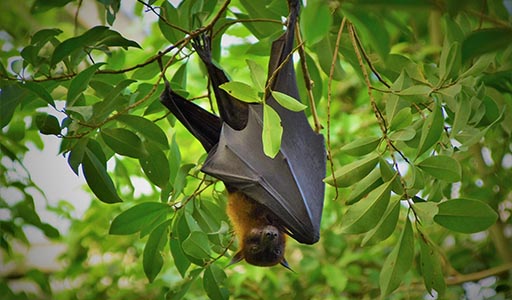Bats

Bat Facts
Bats are the second largest order of mammals after rodents, clocking in at a staggering 1,400 distinct species, 47 of which live in the United States (here are some of the coolest). Equipped with forelimbs adapted as wings, they have the distinction of being the only mammals capable of sustained flight.
Worldwide, bats play essential roles in keeping populations of flying insects in balance. A determined, hungry bat can eat a staggering number of insects per night, a fact that is not lost on farmers or anyone else who finds flying insects troublesome. Many people actively try to make their property more inviting to bats, so valuable is their ability to eliminate insects.
Some bats hibernate, some migrate, and some do both. During hibernation, bats enter a state of reduced metabolic activity called “torpor” where they drop their body temperature and reduce their energy expenditure significantly. While in torpor, bats are unresponsive to outside stimuli. They are so still that mold can begin to grow on them, a condition known as White Nose Syndrome that reportedly kills millions of bats every year. Bats often wind up in human structures such as attics for their winter retreats, or simply dive in through chimneys, often to the chagrin of homeowners. That said, as long as they do not get into your house, bats are a benign, helpful presence.

What does a bat look like?
The appearance of bats varies by species. All bats are divided into one of two categories: megabats and microbats. Generally, megabats have smaller ears, larger snouts, and larger eye sockets, and are often referred to as “flying foxes” since they somewhat resemble foxes. Microbats, on the other hand, have large ears, small, beady eyes, and snouts that appear almost pig shaped. Microbats are much more common to North America, and are what you see zipping around the sky at night. Bats’ wings are much thinner than birds’ wings and consist of more bones. The wing membrane, called the patagium, is a thin, almost translucent piece of skin, with the bats’ veins often visible inside it. The little brown bat, one of North America’s most common bats, weighs less than half an ounce and has a wingspan of 8-11 inches. Most microbats are of a similar size. Megabats, on the other hand, can get quite a bit larger. One of the largest megabats is the giant golden-crowned flying fox (endemic to the Philippines), which can weigh up to 3.1 pounds, and whose wingspan can well exceed five feet!

What does a bat eat?
Like appearance, diet varies by bat species. While megabats prefer fruit, nectar and pollen, microbats are the most significant predators of night-flying insects, eating such bothersome insects as moths, crickets, fruit flies, gnats, beetles, and mosquitos. All bat species native to the United States eat insects. Because of their small size and ultra-high metabolism, bats must consume a great deal of food for their size. Their appetite is so voracious that a single little brown bat—with a body size no larger than an adult human’s thumb—can eat 4 to 8 grams (the weight of about a grape or two) of insects per night. They feed in areas where flying insects abound: over water and agricultural fields, and around streetlights, to name just a few places. Bats get most of their water from the food they eat; however, some bats drink water by flying over the surface of lakes and streams and dipping their tongues in the water. Talk about control!

Where do bats live?
Bats can be found all over the globe, and in most areas of the United States. Bats generally seek out dark, sheltered places such as rock crevices, caves, old buildings, mines, bridges, and trees. Since bats hang upside down (they do this to hide from predators, and to be able to simply drop into flight, instead of getting a running start and taking off, which they are unable to do), they need a location with rough surfaces that they can hang from, as well as a certain amount of height and width to allow them to both enter into flight and land. When bats hibernate in the winter (for those that do), a sheltered, secure area is more important than ever—and few options are as sheltered and secure as an attic.
When do bats give birth?
Most bats mate in late summer and early fall. Males of most bat species use a specific mating call to attract females that is comprised of clicking and buzzing noises. After copulation, the male’s sperm will remain dormant inside the female until the following spring, when the female ovulates and fertilization finally occurs. Depending on the species, the female will give birth two between one and three pups in late May and early June. The pups are born hairless, blind, and overall helpless, clinging tightly to their mothers in the maternity roost. On summer evenings, the mother leaves the roost to go hunting, returning periodically to feed their young. As the pups grow and develop, the mother returns less and less frequently throughout the night. By mid-July, the pups are able to fly and hunt on their own.
Why should we care about bats?
Humans tend to find some animals naturally compelling, while others are not so appealing. For example, many of us would much rather see moose, lions, and rabbits on a jaunt in the woods than snakes, spiders, and bats. Because of the way these animals have been portrayed in myths, folklore, books, and movies, many of us are more embracing of cute, furry animals, even though all species play critical roles in their respective ecosystems. Worldwide, bats play essential roles in keeping populations of nocturnal insects in balance. Just one bat can catch hundreds of insects in an hour, and large colonies of bats catch tons of insects nightly, including beetle and moth species that cost American farmers and foresters billions of dollars annually, not to mention mosquitoes in our backyards. In a single summer night, the 20 million free-tailed bats from Bracken Cave in central Texas eat more than 200 tons of insects!
Living Harmoniously with Bats
Contrary to popular belief, bats are beneficial to have around, since they are the main predators of pesky insects such as gnats, beetles, fruit flies, and mosquitoes. According to the US Fish & Wildlife Service, recent studies estimate that bats eat enough pests to save more than $1 billion per year in crop damage and pesticide costs in the United States corn industry alone. As they have certainly proven themselves with regard to pest control, homeowners can make their property more welcoming to bats by taking the following measures:
- Install a bat box: providing a shelter for bats in your yard could help control the population of unwanted insects around your home. Boxes should be placed 10 to 20 feet high in open areas that receive at least 6 to 8 hours of direct sunlight with morning sun preferred.
- Minimize pesticides: Bats have a ravenous appetite for bugs—they can eat almost 3,000 a night! Minimizing the use of pesticides in your yard can help bats eat their fill of insects. In other words, let the bats be the pesticide.
- Turn off unnecessary lights: Light pollution can deter bats from doing what they do best—inhaling unwanted insects. Keep the light levels low and watch the bats work their magic.
- Remove unwanted bats humanely: Sure, bats are good to have around, but you can always have too much of a good thing—especially if it is roosting or hibernating in your attic. While bats don’t attack humans, a bat infestation is nothing to write off, as bats can carry rabies and their droppings may facilitate the growth of histoplasmosis. If you believe bats have taken up residence in your home, contact our team of experts at Trutech Wildlife.
Bat Species in the United States
While over 40 species of bat are known to live in the US, only a few are common enough to regularly be found in human dwellings:
Big brown bat: The big brown bat is quite large for a microbat, weighing nearly an ounce on the top end, with a wingspan of 12.8-13.8 inches. As the name implies, they have a russet to dark brown color, while the wings, tail membrane, and muzzle are hairless and black in color. They are nocturnal insectivores with a particularly strong appetite for beetles.
Little brown bat: This bat looks, predictably, like a smaller version of the big brown bat, except with a pointy nose. The ears are proportionally large and black and aid with echolocation, which is how they find their prey. Speaking of prey, they like eating gnats, wasps, and beetles, but their favorite meal is a nice mosquito.
Mexican free-tailed bat: The Mexican free-tailed bat is one of the most abundant mammals in North America. Its name is derived from the fact that its tail can be almost half its total length and is not connected to the uropatagium. It has been claimed to have the highest ground speed of any animal (101 MPH) and can also fly at higher altitudes than any other bat species (10,800 ft). They are usually 3.5 inches long and weigh around 7-12 grams.
Pallid bat: These bats are typically found in arid or semi-arid climates, often in mountainous areas near water. They are large bats, weighing 14-25 grams and having a head and body length of 6.2-7.9 cm. Fur is pale at the roots, and brown on their back. They have a blunt, piglike snout.
Frequently Asked Questions
Likely due to the popular saying, “blind as a bat,” many people mistakenly believe that bats are blind. However, over 900 bat species exist in the world, and not one of them completely lacks the ability to see. Still, some types have better vision than others. For example, the two main species of bats, megabats and microbats, have distinct ways of viewing the world.
These larger bats can actually see quite well, especially at night. Their eyes appear oversized relative to their heads, are forward-facing, and give the bats binocular vision. They also have mirror-like retinas that reflect and capture the limited available light. Microbats, on the other hand, have underdeveloped vision. The little brown bat, the most common in the U.S., relies on echolocation to hunt prey and avoid obstacles instead of eyesight. Their vision is just sharp enough to allow them to see beyond the scope of their echolocation.
While some bats migrate to warmer locations in the winter, most will hibernate. Before their cold weather rest begins, these animals mate. Females typically give birth to one or two baby bats, called pups, around mid-May to early June.
When baby bats are born, the pups are blind and helpless. Female bats gather in warm areas, such rafters and attics, to form maternal colonies. A baby bat clings to its mother fiercely at first, and the mother only leaves for short periods in the evening to hunt.
As pups grow and develop, mothers slowly increase their hunting time to wean their offspring. Once the baby bats are about five weeks old, they begin to fly and hunt but may still nurse until they can feed on their own.
Most bats live less than 20 years in the wild, but six species can live more than 30 years! In 2006, this tiny bat made it to 41 years and set a record for the oldest bat.
Some bats return to the safe roost year after year. So if you have bats in your attic, it might turn into a 30 year problem.
Fruit bats, also known as Old World bats or flying foxes, are among the largest bats in the world. They differ from other species because they navigate with their vision rather than echolocation. Fruit bats get their name from their diet of fruit and nectar.
With a long nose, large eyes, and pointy ears, some fruit bat species resemble dogs or foxes. They have wide chests and range from two inches to over a foot long. These bats have coarse, tan to brownish-black fur, wide leathery wings, and tiny feet with strong, claw-tipped toes to grip tree limbs.
Fruit bats feed on nectar, fruit, and even flowers. They chew on fruit to get the sweet juice and then spit out any seeds, rind, or pulp. Larger fruit bats use their claws to climb and find hidden and hard-to-reach food.
Limited to subtropical and tropical climates, the fruit bat is not native to the U.S. However, the pests have a confirmed presence in Florida. Warming temperatures and habitat loss may force more of these mammals into southern states. For now, they are accidental invaders.
Little brown bats are one of the most common types of bat in North America. They thrive from Alaska to northern Florida but are absent from the plains region, where conditions are not suitable. Bats are the only mammals that can truly fly, and the little brown species can speed through the air at up to 22 mph.


